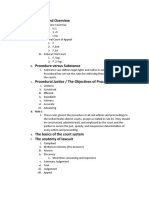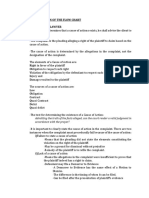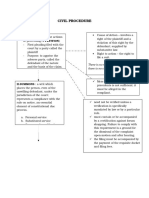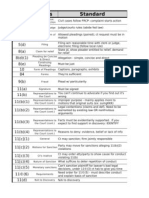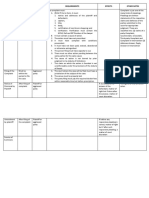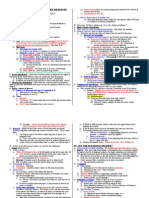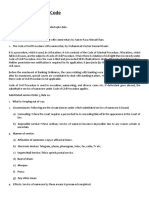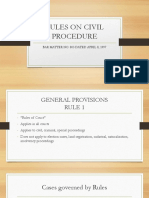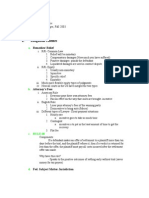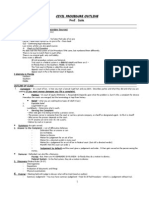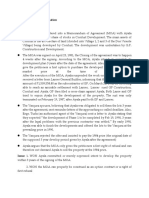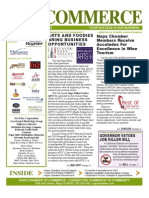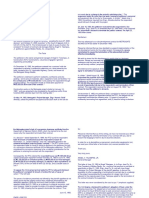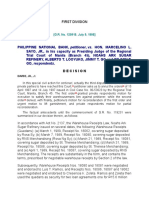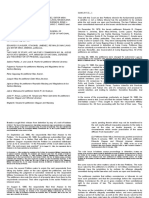0% found this document useful (0 votes)
7 views2 pagesKnowledge Process Scheme
The document outlines the legal requirements for filing a complaint, including necessary information about the plaintiff, defendant, and the petition itself. It details the required annexes that must accompany the claim and specifies conditions under which a demand may be declared inadmissible or unfounded. Judges are mandated to provide opportunities for rectification of defects within a specified timeframe before rejecting a claim.
Uploaded by
ScribdTranslationsCopyright
© © All Rights Reserved
We take content rights seriously. If you suspect this is your content, claim it here.
Available Formats
Download as PDF, TXT or read online on Scribd
0% found this document useful (0 votes)
7 views2 pagesKnowledge Process Scheme
The document outlines the legal requirements for filing a complaint, including necessary information about the plaintiff, defendant, and the petition itself. It details the required annexes that must accompany the claim and specifies conditions under which a demand may be declared inadmissible or unfounded. Judges are mandated to provide opportunities for rectification of defects within a specified timeframe before rejecting a claim.
Uploaded by
ScribdTranslationsCopyright
© © All Rights Reserved
We take content rights seriously. If you suspect this is your content, claim it here.
Available Formats
Download as PDF, TXT or read online on Scribd
/ 2
KNOWLEDGE PROCESS - SCHEME
3.1 LEGAL REQUIREMENTS OF THE COMPLAINT (Art. 424 C.P.C.)
The demand will be submitted in writing and must contain:
1. The designation of the Judge before whom it is filed;
2. The name, identity data, residential address, and legal address of the plaintiff;
3. The name and residential address of the representative or attorney of the plaintiff, if not
he can appear or not appear by himself;
4. The name and home address of the defendant. If the latter is unknown, it must be stated.
this circumstance under oath that will be understood as provided with the presentation of the
demand;
5. The petition, which includes a clear and concrete determination of what is being requested;
6. The facts on which the request is based, presented numerically in a precise manner, with
order and clarity;
7. The legal basis of the petition;
8. The amount of the petition, unless it cannot be established;
9. The indication of the procedural route corresponding to the claim;
10. The evidentiary means; and
11. The signature of the plaintiff or their representative or attorney, and that of the lawyer,
which will not be enforceable in food processes. The respective Secretary will certify the
digital fingerprint of the illiterate applicant.
3.2 ANNEXES OF THE CLAIM (Art. 425 C.P.C.)
The demand will be accompanied by:
1. Clear copy of the identity document of the claimant and, where applicable, of the
representative
2. The document that contains the power to initiate the process, when acting on behalf of
attorney-in-fact
3. The evidence that accredits the legal representation of the plaintiff, if it concerns individuals.
legal entities or individuals who cannot appear on their own;
4. The proof of the quality of heir, spouse, property curator, property administrator
common, executor or the title under which the plaintiff acts, unless such quality is
subject of the conflict of interests and in the case of the official attorney;
5. All the evidence intended to support your request, indicating precisely
the data and anything else necessary for its action. To this end, it will accompany by
separate closed sheet of positions, of interrogatories for each of the witnesses and
open document specifying the points on which the expert opinion will be based, if applicable
case; and
6. The supporting documents that the plaintiff had in their possession.
3.3 INADMISSIBLE DEMAND (Art. 426 C.P.C.)
The claim will be declared inadmissible when:
1. Does not have the legal requirements;
2. The annexes required by law are not accompanied;
3. The petition is incomplete or imprecise; or
4. The proposed procedural route does not correspond to the nature of the request or the value of
this, unless the law allows its adaptation.
In these cases, the Judge will order the plaintiff to rectify the omission or defect within a period not
more than ten days. If the plaintiff does not comply with the order, the Judge will reject the
demand and will order the file of the case.
In practice, the judges order the return of the annexes and instruct that the plaintiff
file a new lawsuit, correcting the indicated defects or omissions (lawsuit in
form.
3.4 UNFOUNDED CLAIM (Art. 427 C.P.C.)
The claim will be declared unfounded when:
1. The claimant evidently lacks standing to act;
2. The plaintiff lacks manifest interest to act;
3. Warn the expiration of the right;
4. Lack of competence;
5. There is no logical connection between the facts and the request;
6. The request was legally or physically impossible; or
7. Contains an improper accumulation of claims.
If the Judge considers that the claim is manifestly inadmissible, he declares it as such immediately.
expressing the grounds of their decision and returning the attachments.
If the resolution declaring the inadmissibility were appealed, the Judge will inform
the defendant's appeal. The higher resolution that decides definitively the
impropriety produces effects for both parties.






